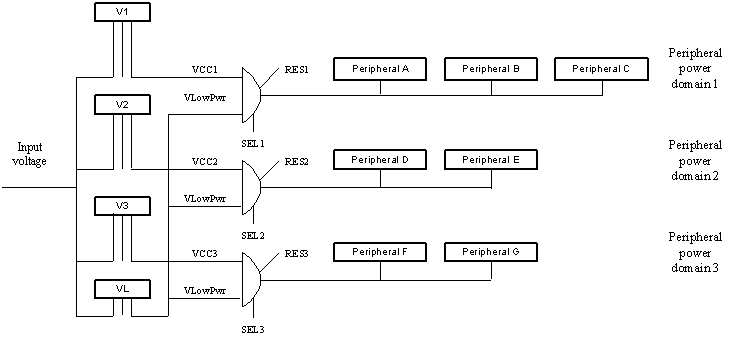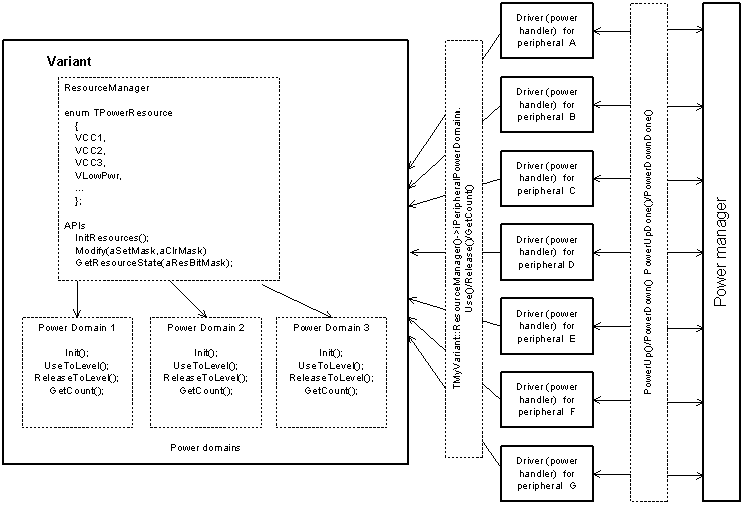Peripheral Power Domains
A peripheral power domain can be defined as being a peripheral, or group of peripherals, whose power supply can be controlled independently from the rest of the device, but not independently from other peripherals within the same power domain.
Power domains depend on the physical wiring of a device, and this must be taken into account by the base port. They are usually manipulated when peripherals or groups of peripherals transition between the Operational Power and Off states.
The following diagram is an example of such an arrangement.
To reduce power leakage, it may be useful to cut the power supply to an area or a group of peripherals in the ASIC or the hardware platform, when all peripherals on that peripheral power domain have moved to the Off state.
In the arrangement shown here, when all peripherals on a power domain have been powered down, the power supply to that domain can be cut off, using the RESn signal.
A suggested implementation would have peripheral power domains modelled by a MPowerInput reference counted object, and controlled using the MPowerInput::Use() and MPowerInput::Release() interfaces that would enable the domain on request. The peripheral driver’s request on that power resource would only be changed when entering the Operational Power state from the Off state, or when entering or exiting the Off states. In other words, a peripheral power domain should only be turned off when all peripherals in that domain have transitioned to their Off state.
This is a suggested definition for a peripheral power domain class.
class PeripheralPowerDomain : public MPowerInput { public: void InitPowerDomain(); // (optional) handles any initialisation void Use(); // implementation of pure virtual void Release() // implementation of pure virtual TUint GetCount(); private: TInt TurnSupplyOn(); // re-establishes power supply to this domain (asynch) TInt TurnSupplyOff(); // cuts power supply to this domain };
The Use() and Release() functions implement a usage count. Peripheral drivers for peripherals on that domain will call these functions whenever their power handler’s PowerUp() and PowerDown() member functions are called, respectively. If the usage count is 0 and Use() is called, it should call TurnSupplyOn(). If Release() is called and the usage count is decremented to 0, TurnSupplyOff() is called.
Often, re-establishing the power supply to a power domain is a lengthy operation and should be modelled by an asynchronous operation. In that case TurnSupplyOn() should be able to sleep the thread in which this function is called until the power supply is stable.
We recommend that peripheral power domains are defined as part of, and accessed through, a resource manager object as suggested in the discussion of Controllable Power Resources. Extending the original A suggested implementation of a resource manager would give us:
class ResourceManager { public: void InitResources(); // called by your Asic::Init3()/Asic::Init1() void Modify(TUint aSetMask, TUint aClrMask); // only 32 simple Resources can be managed TBool GetResourceState(TUint aResBitMask); // only 1 bit set on this mask, returns On/Off public: (MPowerInput-derived) iSharedResource1; // 1 per shared resource (MPowerInput-derived) iSharedResource2; ... PeripheralPowerDomain iPeripheralPowerDomain1; PeripheralPowerDomain iPeripheralPowerDomain2; PeripheralPowerDomain iPeripheralPowerDomain3; ... };
where InitResources() could call each PeripheralPowerDomain::InitPowerDomain().
Peripheral power domains may also be a useful concept when transitioning peripherals to low power mode after peripheral inactivity detection. It is only after all peripherals on a peripheral power domain have requested moving the resource to the level corresponding to low power that the resource level can be changed. This is exemplified again in the block diagram above: when all peripherals in a domain have requested transitioning to low power (using a ReleaseToLevel() -type call) the power supply level to that power domain can be set to VLowPwr.
The following base port software architecture diagram could be used to address control of the peripheral power domains shown in the hardware block diagram above:
Copyright ©2010 Nokia Corporation and/or its subsidiary(-ies).
All rights
reserved. Unless otherwise stated, these materials are provided under the terms of the Eclipse Public License
v1.0.

